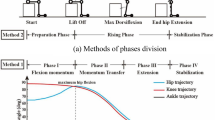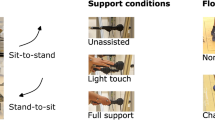Abstract
With the acceleration of the global aging process, the market for the elderly is getting more and more attention. Standing movement is one of the abilities that must be possessed in daily life, and it is also an important factor affecting the independent life of the elderly. As the elderly increase in age, lower limb strength decreases. In daily standing behavior, many elderly people have difficulty in standing, which may reduce the quality of life of the elderly and is not good for the mental health of the elderly. It can be seen that it is of great practical significance to investigate and design assisted standing products for the elderly. Therefore, this study conducted FTSST (five-times-sit-to-stand test) on the young and elderly groups, and found that the time of FTSST in the two groups was significantly different (P < 0.05), but in different genders was not. The method of combining motion capture technology and force plate was used to carry out STS experiments for the elderly. Standing behavior was divided into three phases. The time changes of each phase in the STS process were analyzed. The time spent in phase 3 was the longest. The phase 2 and phase 3 of the STS process need to be focused on. The relationship between GRF (ground reaction forces), joint angles, motion trajectories and assisted standing products was studied. The assistive angle of the assisted standing product was at least 53°. The assistive height of the assisted standing product should ensure that the hip could be lifted at least 250 mm. The standing speed was variable rather than uniform. Changes in GRF and joint angles provided human characteristics data and design references for the design of assisted standing products.
Access this chapter
Tax calculation will be finalised at checkout
Purchases are for personal use only
Similar content being viewed by others
References
Tao, H.: The Research Design of Elderly Lower Limbs Product Based on the Concept of Hospitality Design. Tianjin University of Technology, Tianjin (2015)
Dall, P.M., Kerr, A.: Frequency of the sit to stand task: an observational study of free-living adults. Appl. Ergon. 41(1), 58–61 (2010)
Yamada, T., Demura, S.: The relationship of force output characteristics during a sit-to-stand movement with lower limb muscle mass and knee joint extension in the elderly. Arch. Gerontol. Geriatr. 50(3), e46–e50 (2010)
van Lummel, R.C., Walgaard, S., Maier, A.B., et al.: The Instrumented Sit-to-Stand Test (iSTS) has greater clinical relevance than the manually recorded sit-to-stand test in older adults. PLoS ONE 11(7), e0157968 (2016)
Ayelet, D.: The effect of balance and coordination exercises on quality of life in older adults: a mini-review. Front. Aging Neurosci. 11 (2019)
Quijoux, F., Vienne-Jumeau, A., Bertin-Hugault, F., et al.: Center of pressure characteristics from quiet standing measures to predict the risk of falling in older adults: a protocol for a systematic review and meta-analysis. Syst. Rev. 8(1), 232 (2019)
Linden, D.W.V., Brunt, D., Mcculloch, M.U.: Variant and invariant characteristics of the sit-to-stand task in healthy elderly adults. Arch. Phys. Med. Rehabil. 75(6), 653–660 (1994)
Blake, A.J., Morgan, K., Bendall, M.J., et al.: Falls by elderly people at home: prevalence and associated factors. Age Ageing 17(6), 365–372 (1988)
Schultz, A.B., Alexander, N.B., Ashton-Miller, J.A.: Biomechanical analyses of rising from a chair. J. Biomech. 25(12), 1383–1391 (1992)
Alexander, N.B., Schultz, A.B., Warwick, D.N.: Rising from a chair: effects of age and functional ability on performance biomechanics. J. Gerontol. 46(3), M91–M98 (1991)
Jones, C.J., Rikli, R.E., Beam, W.C.: A 30-s chair-stand test as a measure of lower body strength in community-residing older adults. Res. Q. Exerc. Sport 70(2), 113–119 (1999)
Ohsugi, H., Murata, S., Kubo, A., et al.: Verification of the correlation between cognitive function and lower limb muscle strength for the community-dwelling elderly. J. Phys. Ther. Sci. 26(12), 1861–1863 (2014)
Jones, C.J., Rikli, R.E., Beam, W.C.: A 30-s chair-stand test as a measure of lower body strength in community-residing older adults. Res. Q. Exerc. Sport 70(2), 113–119 (1999)
Lindemann, U., Claus, H., Stuber, M., et al.: Measuring power during the sit-to-stand transfer. Eur. J. Appl. Physiol. 89(5), 466–470 (2003)
Shen, S., et al.: The relationship between ground reaction force in sit-to-stand movement and lower extremity function in community-dwelling Japanese older adults using long-term care insurance services. J. Phys. Ther. Sci. 29(9), 1561–1566 (2017)
Liu, L., Weng, C., Wang, N., et al.: Five-times sit-to-stand test on physical performance for older people. Chin. J. Rehabil. Theor. Pract. 16(04), 359–361 (2010)
Whitney, S.L., Wrisley, D.M., Marchetti, G.F., et al.: Clinical measurement of sit-to-stand performance in people with balance disorders: validity of data for the five-times-sit-to-stand test. Phys. Ther. 85(10), 1034–1045 (2005)
Lei, Zhonggui, Jiayu, Fu, Zhou, Chuang, Wang, Zhixiong: Study on the safety of the elderly standing chair. Comput. Eng. Softw. 39(10), 121–125 (2018)
Wang, J.: Research on Assistive Chair Design for Elderly People. Zhejiang University, Hangzhou (2008)
Acknowledgments
This research is supported by national key research and development program “research on human-centered design and product user experience evaluation technology standard” (2017YFF0206603).
Author information
Authors and Affiliations
Corresponding author
Editor information
Editors and Affiliations
Rights and permissions
Copyright information
© 2020 Springer Nature Switzerland AG
About this paper
Cite this paper
Cai, M., Li, Y., Hu, H. (2020). Research on the Standing Movement of the Elderly. In: Gao, Q., Zhou, J. (eds) Human Aspects of IT for the Aged Population. Healthy and Active Aging. HCII 2020. Lecture Notes in Computer Science(), vol 12208. Springer, Cham. https://doi.org/10.1007/978-3-030-50249-2_2
Download citation
DOI: https://doi.org/10.1007/978-3-030-50249-2_2
Published:
Publisher Name: Springer, Cham
Print ISBN: 978-3-030-50248-5
Online ISBN: 978-3-030-50249-2
eBook Packages: Computer ScienceComputer Science (R0)




